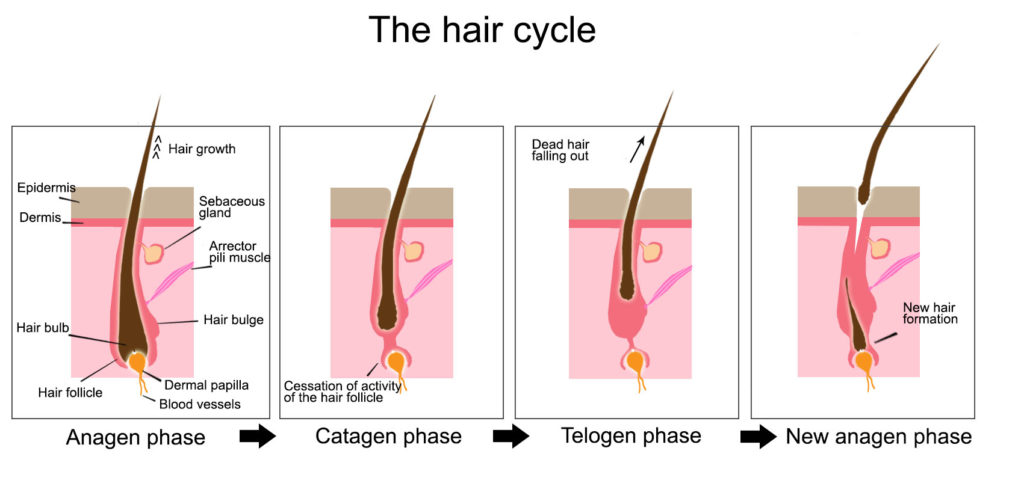Alopecia. Help! I’m losing my hair!
Help! I’m losing my hair!
Hair loss, or alopecia, is one of the most complex disorders dermatologists face each day. Hair growth and hair loss can be affected by so many things: medical problems, diet, stress, and hormones just to name a few. This is the first in a short series of posts about hair loss and alopecia. However, I cannot possibly address everything that is known about hair loss. Instead, it will cover 95% of what I discuss in the office about hair loss each day.
The Hair Cycle
Let’s start by discussing how hair grows. All hairs on the body generally go through three stages: Anagen, catagen, and telogen. Anagen is the active growing stage. Catagen is the transition stage. Telogen is the resting phase. Every day, about 100 hairs shift into the resting phase, 100 hairs fall out, and 100 others kick back into the active growing phase. Most types of hair loss are a problem with the telogen or resting phase. Hairs either don’t enter telogen when they are supposed to, or they get “stuck” in the telogen phase and don’t kick back into the active growing phase. That is a very simplistic explanation, but one I find my patients easily understand.

Hair loss is generally characterized as scarring or non-scarring. Scarring hair loss usually starts with inflammation that leads to the destruction of the hair follicle permanently. Luckily, most types of hair loss are non-scarring.
In most cases of non-scarring hair loss, Rogaine and Biotin are mainstays of treatment. Rogaine works to kick the hairs back into the active growing phase and hold them there. Biotin is the B vitamin that helps the most with hair strength and growth. Let’s discuss them in a little more detail.
Minoxidil (Rogaine)
Minoxidil was originally designed as a blood pressure pill. Those who took the pill grew excessive hair. It was another of those accidental discoveries. FDA approved Rogaine in 1988 as safe to use by men and women. There is no hormonal effect. There traditionally have been two or more formulations, labeled “men” and “women.” Differences in these products are differences in concentration and inactive ingredients, not differences in the active ingredient, minoxidil. Tips on buying and using Rogaine:
1-Get the 5% independent of labeling as “men” or “women.”
2-Get the name brand. You want it to work, and applying it is a lot of work. Splurge.
3-Apply to the areas of hair loss ONLY as directed EVERY DAY for six months. In my experience, patients who stick with the regimen have an excellent chance of growing hair.
4-The diagram that comes in the Rogaine package is to comply with FDA standards because Rogaine was FDA approved for male patterned loss. Applying Rogaine to the entire area of hair loss is okay.
5-Some temporary hair loss will be seen in the first month or so of use because the new ANAGEN active growing hairs are pushing the old resting hairs out of the hair follicles.
Biotin
Biotin is the B7 vitamin that is most recommended for hair and nail growth. It is available over the counter in hundreds of products. The Recommended Daily Allowance (RDA) for biotin is 30mcg. Most multivitamins do not contain the RDA, so often a separate biotin or “hair and nail” supplement may be helpful. Biotin is a water-soluble vitamin, so any excess is excreted in the urine, and super high doses of biotin essentially make expensive bright yellow pee. Despite its widespread use and recommendation, there is little actual scientific evidence that biotin is effective outside of true biotin deficiency which is rare. It is, however, safe and inexpensive and anecdotally effective, so I take an “it won’t hurt” position. Because biotin “strengthens” hair it will take at least six months to see a noticeable change in the hair. It is important to note that biotin WILL NOT affect the hair cycle like Rogaine.
What’s Next?
This post is the first in a series about hair loss. Upcoming topics include specific types of hair loss: Telogen Effluvium, Alopecia Areata, and Androgenetic (Male Pattern) loss. If you suffer from hair loss, Subscribe to Our Site for future posts.
——————————–
If you know someone who may find this article helpful, please share it with them! Follow us on social media this week, and subscribe to our growing YouTube channel! If you would like to receive these posts in your email inbox, Subscribe to our Site.
